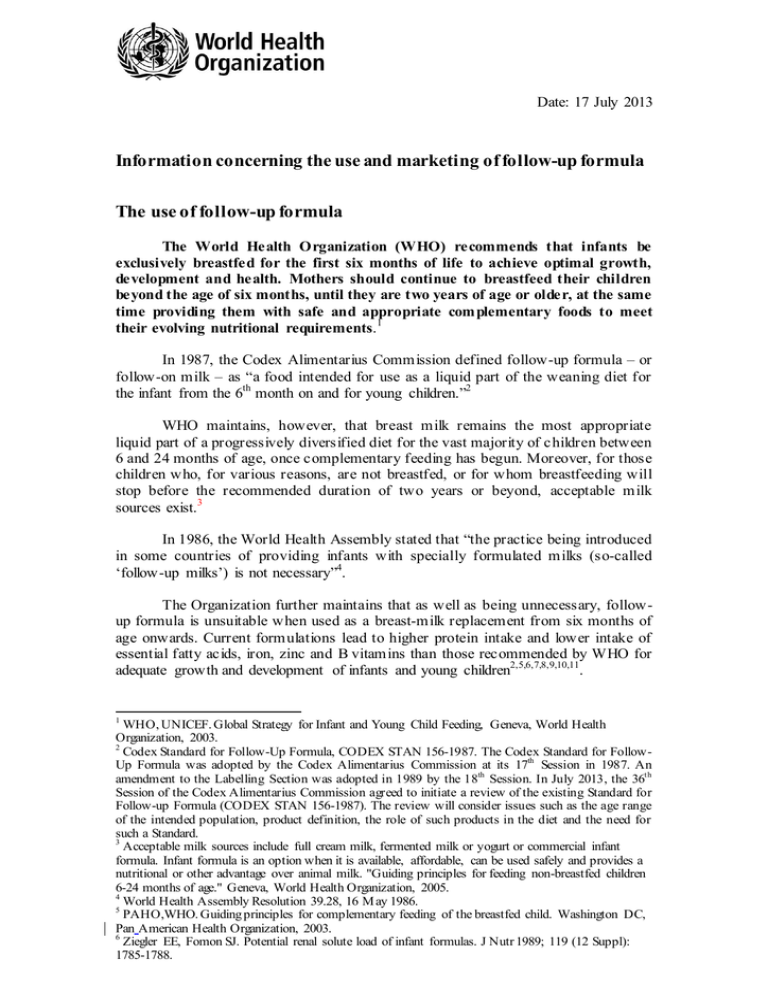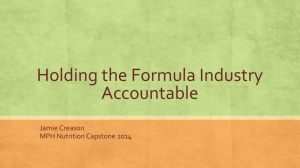Information concerning the use and marketing of follow
advertisement

Date: 17 July 2013 Information concerning the use and marketing of follow-up formula The use of follow-up formula The World Health Organization (WHO) recommends that infants be exclusively breastfed for the first six months of life to achieve optimal growth, development and health. Mothers should continue to breastfeed their children beyond the age of six months, until they are two years of age or older, at the same time providing them with safe and appropriate com plementary foods to meet their evolving nutritional requirements.1 In 1987, the Codex Alimentarius Commission defined follow-up formula – or follow-on milk – as “a food intended for use as a liquid part of the weaning diet for the infant from the 6th month on and for young children.”2 WHO maintains, however, that breast milk remains the most appropriate liquid part of a progressively diversified diet for the vast majority of children between 6 and 24 months of age, once complementary feeding has begun. Moreover, for those children who, for various reasons, are not breastfed, or for whom breastfeeding will stop before the recommended duration of two years or beyond, acceptable milk sources exist.3 In 1986, the World Health Assembly stated that “the practice being introduced in some countries of providing infants with specially formulated milks (so-called ‘follow-up milks’) is not necessary”4. The Organization further maintains that as well as being unnecessary, followup formula is unsuitable when used as a breast-milk replacement from six months of age onwards. Current formulations lead to higher protein intake and lower intake of essential fatty acids, iron, zinc and B vitamins than those recommended by WHO for adequate growth and development of infants and young children2,5,6,7,8,9,10,11. 1 WHO, UNICEF. Global Strategy for Infant and Young Child Feeding, Geneva, World Health Organization, 2003. 2 Codex Standard for Follow-Up Formula, CODEX STAN 156-1987. The Codex Standard for FollowUp Formula was adopted by the Codex Alimentarius Commission at its 17th Session in 1987. An amendment to the Labelling Section was adopted in 1989 by the 18th Session. In July 2013, the 36th Session of the Codex Alimentarius Commission agreed to initiate a review of the existing Standard for Follow-up Formula (CODEX STAN 156-1987). The review will consider issues such as the age range of the intended population, product definition, the role of such products in the diet and the need for such a Standard. 3 Acceptable milk sources include full cream milk, fermented milk or yogurt or commercial infant formula. Infant formula is an option when it is available, affordable, can be used safely and provides a nutritional or other advantage over animal milk. "Guiding principles for feeding non-breastfed children 6-24 months of age." Geneva, World Health Organization, 2005. 4 World Health Assembly Resolution 39.28, 16 M ay 1986. 5 PAHO,WHO. Guiding principles for complementary feeding of the breastfed child. Washington DC, Pan American Health Organization, 2003. 6 Ziegler EE, Fomon SJ. Potential renal solute load of infant formulas. J Nutr 1989; 119 (12 Suppl): 1785-1788. In summary, WHO recommends exclusive breastfeeding for the first six months of an infant's life. Thereafter, local, nutritious foods should be introduced, while breastfeeding continues for up to two years or beyond. Followup formula is therefore unnecessary. In addition, follow-up formula is not a suitable substitute for breast milk , due to its content. The marketing of follow-up formula Even though follow-up formula is not necessary, and is unsuitable when used as a breast milk replacement, it is marketed in a way that may cause confusion and have a negative impact on breastfeeding A number of studies strongly suggest a direct correlation between marketing strategies for follow-up formulae, and perception and subsequent use of these products as breast-milk substitutes. In many instances, the packaging, branding and labelling of follow-up formula closely resembles that of infant formula. This leads to confusion as to the purpose of the product, i.e. a perception that follow-up formula is a breast-milk substitute. This may result in its early introduction, thereby undermining exclusive breastfeeding up to six months of age and sustained breastfeeding up to two years or beyond.12,13,14,15 In 2010, the World Health Assembly stated that the “promotion of breast-milk substitutes and some commercial foods for infants and young children undermines progress in optimal infant and young child feeding” and called upon “infant food manufacturers and distributors to comply fully with their responsibilities under the International Code of Marketing of Breast-milk Substitutes and subsequent relevant World Health Assembly resolutions”16. 7 Complementary feeding of young children in developing countries: A review of current scientific knowledge. Geneva, World Health Organization, 1998. 8 WHO, FAO. Vitamin and mineral requirements in human nutrition, 2nd ed. Geneva, WHO, FAO, 2004. 9 FAO, WHO, UNU. Protein and amino acid requirements in human nutrition. Report of a joint FAO/WHO/UNU expert consultation (WHO Technical Report Series No. 935). Geneva, World Health Organization, 2007. 10 Dewey KG, Brown KH. Update on technical issues concerning complementary feeding of young children in developing countries and implications for intervention programs. Food Nutr Bull 2003; 24:5-28. 11 Codex Standard for Infant Formula and Formulas for Special M edical Purposes Intended for Infants. CODEX STAN 72 – 1981. 12 Scientific Advisory Committee on Nutrition, United Kingdom, Infant Feeding Survey 2005: A commentary on infant feeding practices in the UK, position statement by the Scientific Advisory Committee on Nutrition, 2008. 13 Nina J Berry, Sandra Jones, Don Iverson, It’s all formula to me: women’s understandings of toddler milk ads, Breastfeeding Review, Vol. 18 No. 1, 2010. 14 Sobel H. et al. Is unimpeded marketing for breast milk substitutes responsible for the decline in breastfeeding in the Philippines? An exploratory survey and focus group analysis. Social Sciences & M edicine 2011; 73: 1445-1448. 15 M intzes B. Regulation of formula advertising in the Philippines and promotion and protection of breastfeeding: A commentary on Sobel, Iellamo, Raya, Padilla, Olivé and Nyunt-U. Social Sciences & M edicine 2011; 73: 1449-1451. 16 World Health Assembly Resolution 63.23, 21 M ay 2010. 2 The question thus arises as to whether follow-up formula falls within the scope of the International Code of Marketing of Breast-milk Substitutes (the Code).17 The Code is a set of recommendations to regulate the marketing of breast-milk substitutes, feeding bottles and teats. Its aim is “to contribute to the provision of safe and adequate nutrition for infants, by the protection and promotion of breast-feeding, and by ensuring the proper use of breast-milk substitutes, when these are necessary, on the basis of adequate information and through appropriate marketing and distribution”.18 The Code “applies to the marketing, and practices related thereto, of the following products: breast-milk substitutes, including infant formula; other milk products, foods and beverages, including bottlefed complementary foods, when marketed or otherwise represented to be suitable, with or without modification, for use as a partial or total replacement of breast milk...”19. As reported in a number of studies,12-14 while follow-up formula may not be explicitly promoted as a breast-milk substitute, documented marketing strategies, such as packaging, branding and labelling may induce mothers to use follow-up formula in the first six months of life and/or to stop breastfeeding after this period. If follow-up formula is mark eted or otherwise represented to be suitable, with or without modification, for use as a partial or total replacement for breast milk , it is covered by the Code. In addition, where follow-up formula is otherwise represented in a manner which results in such product being perceived or used as a partial or total replacement for breast milk , such product also falls within the scope of the Code. 17 World Health Assembly Resolution 34.22, 21 M ay 1981. The International Code of M arketing of Breast-milk Substitutes was adopted in the form of a recommendation under resolution 34.22. 18 Article 1, International Code of M arketing of Breast-milk Substitutes, World Health Organization, Geneva, 1981. 19 Article 2, International Code of M arketing of Breast-milk Substitutes, World Health Organization, Geneva, 1981. 3
